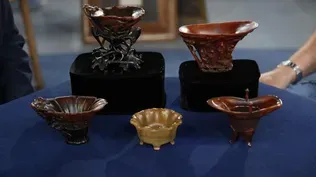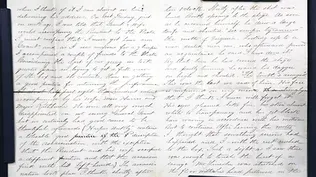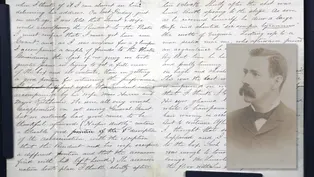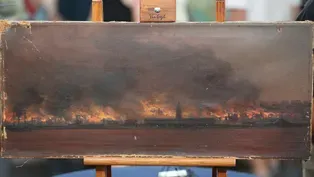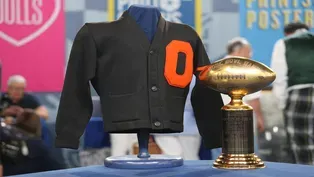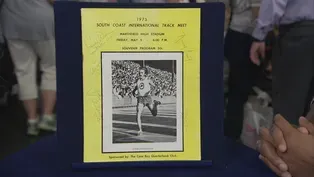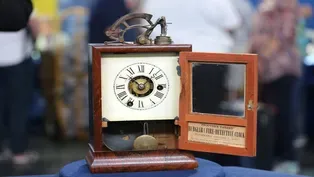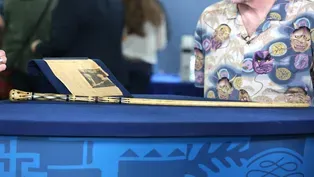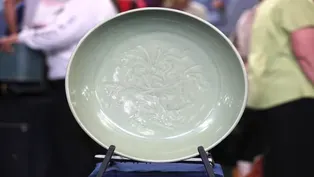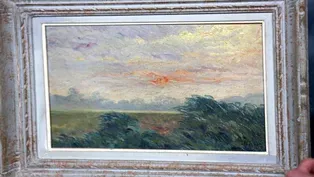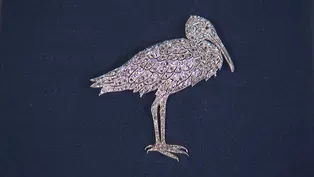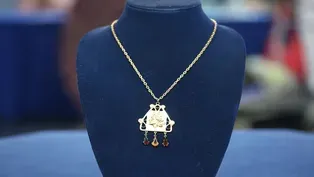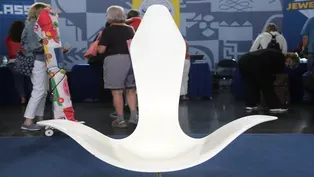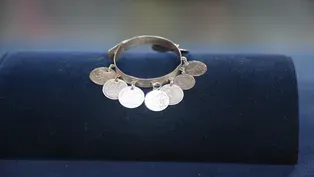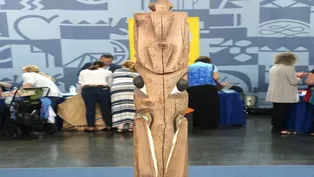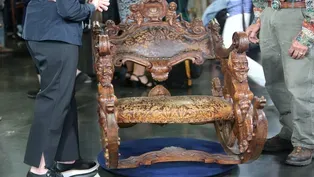

Portland, Hour 2
Season 22 Episode 11 | 52m 31sVideo has Closed Captions
Rose Bowl trophy, Evel Knievel leathers, and a Ming Dynasty bow. Which is up to $100,000?
Take a passage to Portland to learn more about antique and vintage items like a 1942 Oregon State jacket and Rose Bowl trophy, a Ming Dynasty celadon bowl, and Evel Knievel leathers from around 1967. Can you guess which item is valued for up to $100,000?
Problems with Closed Captions? Closed Captioning Feedback
Problems with Closed Captions? Closed Captioning Feedback
Funding for ANTIQUES ROADSHOW is provided by Ancestry and American Cruise Lines. Additional funding is provided by public television viewers.

Portland, Hour 2
Season 22 Episode 11 | 52m 31sVideo has Closed Captions
Take a passage to Portland to learn more about antique and vintage items like a 1942 Oregon State jacket and Rose Bowl trophy, a Ming Dynasty celadon bowl, and Evel Knievel leathers from around 1967. Can you guess which item is valued for up to $100,000?
Problems with Closed Captions? Closed Captioning Feedback
How to Watch Antiques Roadshow
Antiques Roadshow is available to stream on pbs.org and the free PBS App, available on iPhone, Apple TV, Android TV, Android smartphones, Amazon Fire TV, Amazon Fire Tablet, Roku, Samsung Smart TV, and Vizio.
Buy Now

ANTIQUES ROADSHOW 2025 Tour!
Enter now for a chance to win free tickets to ANTIQUES ROADSHOW's 2025 Tour! Plus, see which cities we're headed to!Providing Support for PBS.org
Learn Moreabout PBS online sponsorshipMARK WALBERG: "Antiques Roadshow" is in the City of Roses, Portland, Oregon.
This is a Rose Bowl trophy from... it was actually my grandfather's in 1942.
Really?
That's kind of amazing.
♪ ♪ WALBERG: There are plenty of opportunities to stop and smell the roses in Portland, where the rose has become an emblem of the city.
At the International Rose Test Garden, hundreds of rose varieties have showed off their beauty since 1917, when Portland stepped in to rescue and nurture rose plants from Europe that were thought to be vulnerable to the weapons of World War I.
Everything is coming up roses back at the Roadshow, with this rare 1942 Rose Bowl trophy.
Check it out.
This is a Rose Bowl trophy from... it was actually my grandfather's.
It was Oregon State and Duke University in 1942 for the Rose Bowl game.
And it was played at Duke.
It is the only year that I know of that the Rose Bowl was actually on the East Coast.
Usually it's played in-in California.
And it was Duke and Oregon State.
Actually, Oregon won.
Tell me about your grandfather and his role on the team.
His name was Louis Shelton, or he went by "Choc," Choc Shelton.
And he was a fullback for the Oregon State Beavers.
He was Choc because from an early age, he really liked chocolate, so it was just a nickname that stuck throughout his whole life.
So, actually, people, I don't even think, knew his name was Louis, but everyone called him Choc.
And so here we are in Portland, Oregon.
Yup.
And we get to celebrate some Oregon State Beavers football history today.
That's right.
Was there anything else the family told you about the trophies?
It's been through... some rough times.
There's a couple dents and scratches.
So, as you mentioned, the 1942 Rose Bowl was moved to Duke, to North Carolina, to play Duke because of the security concerns after the bombing of Pearl Harbor.
Right.
So, as you said, they loaded up the teams, they went cross-country, and the only time in history they played the Rose Bowl outside of Pasadena.
Right.
Started in 1902, and going to this to now, that's the only time they ever played.
The Tournament of Roses East-West Game, it was called.
Oregon State Beavers football history, do you know how many times they were in the Rose Bowl?
I don't know.
Okay, three times they were in the Rose Bowl.
Okay.
In this case, they defeated Duke, who was heavily favored, and they did beat them, as you said, 20-16 in that 1942 Rose Bowl.
We only know of two years, I can only find two years in the 1934 and the 1942 Rose Bowls where the players and/or coaches, or both were issued trophies, everybody on the team.
Now, the interesting thing for Duke from this trophy, Duke only awarded this trophy to their coaches and coaching staff, not to the players.
So, that dent can be corrected, in my experience, for somewhere between maybe $400 to $600.
Okay.
And then it does have a little smudge right here.
When my grandfather came back, his high school sweetheart was my grandmother, and she had a much younger sister, and she wanted to see the trophy and she had lemon juice on her finger, and she touched the trophy right here and actually marked it.
So, from pretty much the get-go, it's always had this little mark on it, right here.
Have you ever had these items appraised before?
Never.
Well, his letterman's jacket-- on this one, it's in excellent condition.
Again, we have the provenance of him playing at Oregon State.
On this one I would put a value for insurance of $750.
Not bad.
Now, the trophy.
For insurance value, I would put a value of $7,500.
Are you kidding?
(laughing): Wow, that's crazy.
That's crazy.
Wow, well, I don't plan on selling it, but that's amazing.
WOMAN: It's a letter from my grandfather.
It was written in 1865.
He wrote to his uncle, and he was in Washington, D.C., at the time.
He and some friends went to the theater one evening because they had heard that Grant was going to be there, so they thought they want to make sure they could see him.
Your grandfather is in Washington in 1865-- Correct.
And he's going to the theater to see Ulysses Grant.
Yes, who he thinks is going to be there with President Lincoln.
You remember which theater they were going to?
Oh, now, that's not fair.
(laughing) Well, they were going to the Ford Theatre.
Ford Theatre, yes.
As is mentioned in the letter.
The letter's written on April 21, 1865, and your grandfather is at the theater on the Friday before, which was April 14, the day of the assassination.
And it is just incredibly moving.
The detail of the letter just blew me away.
(chuckles) So we get the date here, April 21, 1865, and he's describing the events, like he's describing positioning himself to see the president.
Let's turn the page here, and if you can give me a hand, we can get to the inside and the more descriptive part of the letter.
Written in a wonderful hand, and just a very incredible style.
Your grandfather was a very gifted writer.
So he's at the theater, he's describing what is going on.
"'Harper's Weekly' "contains a good description of the assassination, "with the exception that "the president and his wife occupied a different position and that the assassin fired with his left hand," underlined.
So "Harper's," according to your grandfather, made the mistake of not really accurately describing the event.
Up here, this just said, you know, "Shortly after the shot was heard, "Booth sprang to the stage, he broke his ankle there.
"As soon as he had recovered himself, "he drew a large knife and shouted, 'Sic semper tyrannis, "the motto of Virginia.
"Looking up to a man seated near me "who afterwards proved an acquaintant, "he said, 'I have done it.'
"By that time he had crossed the stage, "and partly turning, "he waved his dagger on high "and shouted, 'The South's avenged.'"
This description just... let's my... let's my hair stand up.
(chuckles) It's just unbelievable.
Where do you keep it?
At the bank.
(laughs) In a safety deposit box, right.
Yes, and I'm really concerned, because I think it needs some sort of preservation, for sure.
It does.
The letter written by your grandfather, he wasn't like, a recognized person, right?
So a letter written by him would be-- just have a very dear family value.
But the contents of this letter just makes it so incredibly important.
A conservative estimate at auction would be $10,000 to $15,000.
I would expect it to go much higher than that, but at auction, you want to play things safe, and you also want to get people to bid, and so $10,000 to $15,000 would be an awesome starting point.
Violin here from 18... Something.
Oh, neat, okay.
I think it's in Germany it was made, and we just want to learn some more about it.
Yep, it's going to go to musical instruments.
Okay.
And so it's really a neat little piece.
What did you pay for it?
WOMAN: Well, I don't even remember, it's been ten, 15 years ago.
I just thought it was interesting, so I bought it.
Maybe five bucks.
I think it's probably worth about that now.
Condition's a big deal, but it's-it's really a cool piece.
This was from my grandfather, and it might have been his father's, but we don't know that.
Well, it's a cool gun.
It's a .44 caliber Colt.
It's known as a Dragoon model.
This was the best gun you could buy from Colt Manufacturing at the time.
Probably somewhere between $8,000 and $10,000 as a group.
It's been in my family for five generations and I got it... this would have been my grandparents'.
It came to me through my parents.
So, in the article, it talks about what the cane is.
Yeah.
But it mentions the materials that the cane is made from, and the main material that it mentions is ivory.
Mm-hmm.
Which, traditionally, has been a sought-after material for decorative art objects.
Yeah.
Currently, ivory is not a sought-after object, because of our protection of elephants and other endangered species.
Right.
And the interesting aspect about this cane is it does date from the late 19th century, mid to late 19th century.
It does have a whaling history to it because of the material it's made from, which is not ivory, it's whalebone.
Oh.
So, the shaft is whalebone, the handle is whale tooth.
Oh.
And this would have been a sailor-made object, and a lot of the materials within the cane can sort of tell the story about the travels of the sailor who constructed it.
Oh.
So we have abalone and mother of pearl.
We have-- this is ebony in here, which is an African wood.
Mm-hmm.
So, these would be materials that the sailor would have picked up along the way, including whalebone on an active whaler, and this type of thing would've been constructed in those down hours, of which there were many, between whales and between harvesting and things like that.
In the condition that it's in right now, I think at auction we're looking at a $3,000 to $5,000 value.
Oh, very nice.
I brought this chair that I got at a thrift store, I think in 1995 or 1996.
Whereabouts?
In Anchorage, Alaska.
Okay.
Did they tell you anything about the chair?
No, no, it was just a thrift store, you know, with a bunch of stuff in there, and I just saw the chair and I fell in love with it, and bought it and brought it home.
It was like $12.50, I think.
Well, I need to go to thrift stores with you.
Yes, you do.
That's quite a find.
This is referred to as a tulip-form chair, and the tulip is an organic form that's very popular in design in mid-20th century furniture, as well as decorative arts.
Erwine and Estelle Laverne are the designers of this chair, and unlike their contemporaries, they were not designers or architects, they were artists.
They met in New York, they married, and created a very successful company, producing not only furniture, but textiles and wallpaper as well.
There's some discrepancy about when the chair was made, but consensus says between 1957 and 1960.
It is made of fiberglass.
I want to take a moment just to spin this around so that our viewers can see... see this in its entirety, where you can see the fiberglass.
The base is enameled metal, so, very innovative.
Fiberglass was really developed in World War II, and post-war furniture design, they incorporated it into furniture, so... My dad had the first fiberglass boat in Bristol Bay, back in the late '50s.
So, I knew that this was fiberglass.
Okay.
But only because of that, otherwise, why would I know?
(laughs) Great form, great presence, great stance.
There are a few condition issues that we could point out, and these really do show.
There was a crack right here.
And you can see, also, just some little... a few little chips and bangs here and there, as well as the base-- you can see it around the base.
Which is normal wear that you're going to see on a chair that's really 60 years old.
We had it outside a bit, you know, because it was fiberglass, so I thought if the boat could be outside, the chair could be outside.
Very durable product, so... Yeah.
In today's world, it's a very desirable chair.
At auction, it would realize between $1,000 and $1,500.
Wow.
Oh, that's great.
Well, it is a family heirloom, then.
Now it is?
I think I'll keep it, yeah.
(laughing) Yeah, yeah, it's very comfortable, too.
Did you sit... would you like to sit in it?
I did sit in it.
It's very comfortable.
Shall I sit in it?
Yes, please.
Thank you.
And it rocks.
You can... Yeah.
You look great in that chair.
(laughs) Wow, with that... wow.
I don't hear that enough.
Oh, man, that chair is happening for you.
Thanks, Laurie.
Thank you.
My father was living in Santa Rosa and going to Santa Rosa Junior College in 1964, '65, and the beginning of '66.
And he also was working at a museum there, so either by taking a class from Schulz's wife, possibly, or perhaps by meeting them at the museum.
Somehow, he met Schulz's wife, and she invited him to dinner, where he met Mr. Schulz, and I guess they talked and perhaps even disagreed about politics a little.
(laughs) My dad was a real liberal, and had strong feelings, but they got along real well, and enjoyed each other's company, and at the end of the night, Mr. Schulz gave him this "Peanuts" strip to take with him.
So, it got put into his trunk, and then, unfortunately, my father ended up going to Vietnam and passing away soon after that, so it's been in a trunk 50 years.
And it was recently found and my uncle and aunt said, "Oh, you should have this trunk," and so that's how I received it and how he received it.
Oh, wonderful.
So let's see how it's marked.
"1965, United Feature Syndicate."
And it shows two of the main characters: Charlie Brown, obviously, and his dog, Snoopy.
And this is part of a charming little vignette where Snoopy is ice skating, and he sees his future fiancée.
The beagle of his dreams.
And so here he is, waiting for her to come.
Sadly, by Valentines Day, they had broken up, but this is really a fabulous panel.
And so it's signed by Charles Schulz.
We have a little, probably, water that got on the signature, and so it's a little bit smudged, but it's still an original piece.
Do you have any idea what it's worth?
I really don't know.
I was thinking it would probably be at least $1,000, but I don't know.
Especially with the water damage.
This particular one is very interesting because you have all of this heavy ink, and the printers hated these because they couldn't saturate well on newsprint.
It really pops.
It's a real collectors' piece.
In this condition, even with the little problems here, conservatively, at auction, this would bring between $15,000 and $20,000.
Oh, my gosh.
(laughing): That's amazing!
And I have to tell you because it's so graphic, it could even bring up to $30,000, which is what I would say you should insure it for.
Oh, my gosh.
That's amazing.
(laughing): I can't believe it.
I can't believe it, I wish my dad could have known.
(laughs, sniffles) In 1992, I went into a house with a partner and this was part of his collection.
We discovered soon after getting into the house that he was terminally ill.
Okay.
And I was his primary caregiver during his declining days.
He willed the collection to me.
And what do you know about this clock?
Only what he told me.
It's called a burglar and fire alarm, has several unique functions that you can see are performed by the device on top of it.
If the alarm goes off, say during the winter months, before it's light, you mount a kitchen match here, cock this back, when the alarm goes off, the match is scraped along this rough surface, a little wire here flips the cap off of this small kerosene lamp and the match lights the lamp so you get up to light.
Correct.
The burglar and fire alarm functions, there's a little wire here that you attach a thread to.
That thread is attached, say, to a door, and the door is opened, this falls down, the alarm goes off.
If the thread is burned, the tension is released, this goes down, and the alarm goes off.
So it has several functions.
Right.
Which is interesting, and that's sort of the way it was advertised, as being the hardest-working clock in the business at the time.
Oh, yes.
Because it had all these functions.
This was made by the Seth Thomas Clock Company, and it's primarily just a little kitchen clock, or a cottage clock.
But this one's very unique, because it has this Proctor Patent device at the top that was made in Beverly, Massachusetts.
And these are exceedingly rare clocks, and what's even more rare about this clock is its condition.
It's perfect.
It's one of the best I've seen.
That's nice to hear.
It has this beautiful rosewood case, and this appears to be American rosewood.
It has this wonderful gilding, it has the "S" and the "T" for Seth Thomas, the clock company that made it.
And if you open up the door, it has beautiful labels.
It has Proctor's Patent Burglar and Fire-Detective Clock, and then another label inside of the Seth Thomas label.
And it even has... a great label on the back that's perfectly intact, and really almost a hundred percent there.
But these clocks, I say they're exceedingly rare.
Why do you think they're exceedingly rare?
They probably burned up in fires.
(laughing) Exactly.
I think they started more fires than they probably warned people about.
Could be.
A very interesting clock, and exceedingly rare, but I could just picture this match being thrown across the room and hitting some drapes and lighting the house on fire.
If you were to have this clock without this mechanism at the top, it would be a $300 clock.
Because it has this, and because it's rare-- we don't see many of them at all-- this would sell in a retail situation for $2,500.
Oh, great, great.
I had no idea.
I-I-I couldn't have...
I didn't have a clue.
I mean, I love these objects.
I collect a lot of natural history, and these are quite typical of anatomical models that were made in the 19th century.
APPRAISER: I don't it's human, I think maybe horse hair.
WOMAN: Oh, you do?
Okay.
Yeah.
I think horse hair.
Okay.
But it is fine, it's not a...
It's not from the tail.
(laughs) There you are.
(laughs) I think he was a traveling painter, and came in and did this, and I want to say it was done between 1850 and 1900, I have no idea.
I think it's later.
You think it's later?
I think it's after 1900.
Okay.
It's a talented painter, certainly not the first time they've done this.
WOMAN: These belonged to my great uncle.
They actually belonged to his wife, one of his wives, and these were passed down from my grandmother to me.
APPRAISER: These are a pair, and they always came in a pair, and they're called garter bracelets.
Oh.
And it came... it was a fashion set by Queen Victoria in England, and as the queen, she was head of the Order of the Garter, which was the ultimate chivalry order in England.
And normally you wore your garter on your leg, and it would be visible when you were riding.
Now, Queen Victoria did not like to show her legs in public, so she wore her garters on her arms.
So, people followed this trend, eventually made gold, gold bracelets that looked like the garters.
Oh.
What's great is they survived as a pair.
Right.
Because as you can imagine, since they were made in the 1870s, and are passed down from generations, a lot of times they're split up between daughters and daughter-in-laws and all that fun stuff.
But the only little bit of condition issue is one has this little piece which keeps the adjustable bracelet in tact, and this one doesn't.
Uh-huh.
Mm-hmm.
But otherwise, they're in great condition.
They have this beautiful black tracery enamel, and the original seed pearls in there.
They're absolutely beautiful.
Do you have any idea about how much they're worth?
Absolutely none.
I would say if these came in to auction, I would estimate them somewhere between $3,000 and $5,000 as a pair.
Wow.
So are they solid gold all the way through?
They are solid gold all the way through, yes, they are.
They are, that's wonderful.
Thank you very much.
You're welcome.
Well, today, you brought me a painting that looks like it's been through an earthquake.
It... yeah.
It's had better days.
Yeah.
What do we have here?
A painting that's oil on canvas, and what's it of?
It's the fire after the San Francisco earthquake.
We checked with a friend who's a sailor who said the only person who's seen it of importance-- who said that the running lights for the ship are actually accurate.
So, I figured whoever did this from Angel Island in the bay was there and either drew or painted or took notes, so that they would be absolutely accurate historically.
Where'd you get it?
My husband-- his father bought a really gorgeous old Victorian in San Mateo, California, that had been run down and turned into a boarding house.
And his dad said, "If you'll come help me clean the attic, you can have anything you find that you want."
And he wanted a chest of drawers that was over against the wall.
But he pulled the chest of drawers out, and this fell out from behind it, and Greg said, "I'll take this."
So, we've had it ever since.
That was 1969... '68 or'69.
At one point, we tried looking it up at the library, and there are so many... it's apparently an Anderson.
There are a lot of Andersons.
So we just... we gave up.
We've kept it as a sentimental treasure.
As you mentioned, the earthquake, having lived there, it's one of the things we mention about San Francisco, they call a fire an earthquake.
(laughs) Most of the damage that was done was done by the fire.
Right.
Following the earthquake in 1906, we see this here raging throughout the city several days afterwards.
In fact, what was interesting after the fire, there was an impetus to do the Hetch Hetchy Dam, the reservoir, because they said, "If we had the water, we could've st... stalled the fire."
And there was actually... much more damage was done trying to stop the fire by building fire breaks with dynamiting buildings, and that only exacerbated the situation.
Right.
So it's really important to have this document here.
As you've said, it's very accurate.
You mentioned Angel Island, I'm curious why you thought it was Angel.
The perspective, because Treasure Island hadn't been built yet.
And the only place we could figure that you would get this view of the Ferry Building would be from Angel Island.
Well, actually, Angel Island would be out around here.
Oh, really?
A little bit, yeah.
What you're actually looking at is from Yerba Buena Island or a ship off of Yerba Buena Island.
Treasure Island is a flat spot that was built for the 1937 fair, or '39 Golden Gate Fair, built in '37.
Right.
Right.
And that's a flat area off of Yerba Buena Island, which is where the Bay Bridge goes through.
So it's probably from there, because this is the Ferry Building.
The iconic Ferry Building.
Right.
Yes, yeah.
And you're looking straight onto it, and then the hill, and this would be over toward Telegraph Hill over here.
You mentioned the running lights.
Here, you have the port and starboard running lights here for the ships, the little greens, and they're almost not seen, the little green and red spots, just the subtlety and accuracy of the piece.
As you said, it is Anderson, it's signed "AV Anderson" and then dated 1906.
And there is an artist by the name of Arvid Victor Anderson, who was in San Francisco.
He was a Swedish person who comes there in 1888.
Whoa!
Whoa!
That's just cool!
Yeah, and actually painted this.
The piece itself, is, as I said, has been through an earthquake, or it seems like it.
Oh, yeah.
Obviously, you see the frame abrasions up here and down here where the frame is beat up.
On the back, there's a label for the framer, stating it's from San Francisco as well.
And there's mold up here, even.
These little spots are mold spots.
So this can be cleaned up, and it would brighten up a bit.
By the way, the dog who did that lived.
(laughing) It was a very close call.
These are fang marks?
They are, and it was a very close call.
The artist himself, his paintings normally sell for a few hundred dollars.
I've never thought-- yeah.
Arvid Anderson, a couple that have come up at auction.
Right.
I would think a value-- an auction estimate or fair market value in that range would probably be around $5,000 to $7,000, because it's that important of an object.
Whoa.
I... we never... no.
I... (laughs) I never expected to be here.
I thought we'd come in and somebody would say, "It's historically pretty, it's $500 or $600."
That's...
I think they'll pay attention.
(laughing) I think they'll... Well, you just don't get these every day.
No.
Whoa.
I'm a happy camper.
I am a very happy camper.
Probably about 20 years ago, my husband and I would visit estate sales, and a young man was cleaning out his grandmother's home and my husband has eagle eyes for certain kinds of things.
He found this.
It was very black looking, so you really couldn't tell what was on the discs, and he gave it to me and said, "You like this?"
And I said, "Yeah," and we paid a dollar.
Fair price.
(laughing) Have you used it?
Oh, I wear it fairly often, yeah.
What I do know, there are coins, and some of the coins are U.S. coins, I think there's a Canadian one.
They're primarily a coin on one side, and engraved with initials on the other side.
There's one coin that is engraved two sides, and some are more worn than others.
The oldest one has a date of 1854.
It's made out of silver.
It's called the love token bracelet.
The construction is very archaic.
It's a simple strip of silver that's built like a belt, caught in the back with a hasp.
So, love token bracelets were popular in the 19th century, and the dates here are 1854 to 1879.
But what really drew me to this bracelet is there's one on there that speaks to my history.
I'm a Brooklyn girl.
Uh-huh.
That is the Brooklyn Bridge.
And it's got that very recognizable column here.
Uh-huh.
And you can see the river below.
It's contemporaneous to the bracelet.
The bridge starts construction in 1869, which takes 14 years, ending in 1883.
And it was a great marvel of its time.
Uh-huh.
Brooklyn is seeing a renaissance.
If we went back to Brooklyn, we'd be the oldest two people in the borough.
(laughing): Yes.
Love tokens sell for between $65 to $85 apiece.
We have nine love tokens here, and I would give the bracelet a normal value at auction of nine times six, maybe $300 to $500, $500 to $700.
Wow.
Because of the bridge, because of that one love token here, I wouldn't have any problem giving that an auction estimate of $800 to $1,000.
My goodness.
Wow.
WOMAN: A woman was moving to Alaska and she did not have room in her trailer for it, so I went and purchased it from her.
I just moved up here from L.A., I wanted a little bit of Pacific Northwest decor, and I just thought this one was really interesting, but not very loud.
It's nice and subtle in the colors, so I got it.
What do you like best about it?
If this is a beak, I like this part about it, but it's just a great piece for a corner.
It takes up a lot of room.
It's nice.
It is a beak.
Okay.
Yeah, it looks like a big raven.
Okay.
That's what... that's what I think it is, and I think it's a really elegant, beautiful piece.
The question with all of these is are they Native carved by indigenous people, are they made by skilled Boy Scouts, or a guy with a chainsaw?
(laughing) Right.
At the flea market.
And this one, I think it's a Native carver, and so do the other people at the table.
Wow.
We all, when we saw it, we think it's made by one of the carvers that's in the southern end of those Northwest Coast tribes.
Maybe a Nuu-chah-nulth carver.
I think this was probably carved to sell.
It's based on traditional carvings in this area.
They carve like this clear up through British Columbia.
Oh, okay.
And... but the styles vary as you go south from north, and I think this is on the southern end of all this.
It is cedar, or Douglas fir.
Oh, okay, good.
And so it's the right kind of wood on top of that.
We had no idea.
Yeah, and it's old.
It's probably at least 50 years old.
Wow.
It could even be a little older.
Okay.
If you went into a gallery in-in Portland or Seattle, and this was for sale, I would think it would be between $3,500 and $4,000 to buy it.
(laughing): You're kidding.
No, I'm not.
So, you know, I think it's a beautiful thing, and, you know, well done.
Oh, wow.
I like the colors and like the way it's carved.
And it shows hand tool work on a lot of the carving, like these big eyes.
That looks like it was all done with hand tools and not with any kind of mechanical tool.
That's great.
So, yeah, I think you did pretty good overall, you know?
I did fabulous.
I only paid $150 for it, so... And you enjoy it.
I love it.
I mean, you like it.
I really do.
I wouldn't have bought it if I didn't enjoy it.
I used to work in Africa in the oil field, and I bought this in Cabinda, Angola.
A little too small for me to fit on my head, you know, but... (laughs) Fantastic.
This is 15th century.
Okay, thank you!
Really early, beautiful, kind of typical of the workmanship from that period of time, celadon jade.
There's a plaque that was either set into a belt or some other garment.
Likely going to fall in the $3,000 to $5,000 range.
Honestly, if you don't like this image, there's something wrong with you.
Right?
Because who doesn't like puppies?
At auction, currently, this one alone would sell for between $400 and $600.
WOMAN: Well, it was my grandmother on my mother's side, and we believe she had some French in her, so we think it's probably from France, and it's been in our family for a very long time.
Doesn't come out of the box too often, don't, you know, have much occasion to wear it, but I've always just loved it, and just think it's gorgeous, and wanted to find out more about it.
These are beautiful diamonds.
They're mostly rose-cut, and, yes, it is French.
We do not know the maker, it's Art Deco, platinum, diamonds.
I counted a little over 200 diamonds in there.
Oh, wow.
And so you've got a little over two carats of stones.
Okay.
I like costume jewelry, that's my gig.
And I see pieces that are copies of this.
Oh!
But rarely do I find the authentic piece.
He's beautiful.
Have you ever had him appraised?
Not really.
I... we did find out from an insurance policy that they had in 1959 that they had valued it at about $1,300.
Okay.
So that was probably about the last bit of information we've had.
Well, on today's market, I would say retail value between $6,000 and $8,000.
Ooh, that's nice.
And so many diamonds, too, wow, thank you!
That's wonderful.
Thank you.
I found it in my parents' garage about five years ago, tucked away behind a bunch of boxes.
At first, I had no idea what it was, but it seemed relatively significant.
So I pulled it out, and lo and behold, my father would tell me, "Oh, that's the Dalí."
Apparently, my uncle owned an art gallery in Chicago back in the day, and my father either gave him a loan or invested in the gallery a while back and this was repayment of the debt or a thank you for the investment.
Did your dad have any idea what it was?
I mean, aside from the Dalí?
He did, he did, not aside from knowing that it was a Dalí, I think he just liked the way it looked.
I'm not even sure if he got to pick exactly what he got, but other than that, that's all he's told me, and that's all I know.
It's sat in my basement ever since.
It's not in the best condition, so... Is this how you found it?
Yes.
I sprayed some Windex on the glass this morning, before I brought it in, maybe wiped a few cobwebs off, but that's it.
Nice work.
All right.
So it's a lithograph by Salvador Dalí.
Okay.
He signed it down here in pencil, and you can see down here, it's a limited edition of 150, pencil numbered there.
Okay.
He made this lithograph in 1965.
The lithograph's title is "Drawers of Memory."
It's based on an earlier sculpture, as well as an earlier painting that he had made in 1936.
Wow, okay.
The sculpture is now very well known, it's called the "Venus de Milo with Drawers."
So, it's the famous Greek sculpture.
Yeah.
He made a replica of that and put drawers on the statue.
Okay, fascinating.
And he was... this was in 1936, and he was very influenced by Sigmund Freud.
And Dalí once said that the only difference between the ancient Greek norm of the human body and then the body post-Freud was that Freud had made the body full of secret drawers.
Very interesting.
So, this lithograph is based on those two earlier works-- the painting, now in a German collection, the statue, the "Venus de Milo with Drawers," in the Art Institute of Chicago from 1936.
Oh, okay.
This is in reverse of the painting.
The lithograph was published by Sidney Lucas, who had a gallery in New York and worked very closely with Dalí in the mid-1960s.
Oh, really, okay.
Condition on it, it's a little buckled at the edges.
Yeah, I noticed that.
I'd probably re-matte that.
Okay.
Is that all it would take?
Yeah, it's probably just slipped in the matting, and so it's buckled up like that.
All in all, it looks like it's in great condition to me.
Really?
Wow.
And it's one of Dalí's largest lithographs.
Mm-hmm.
And it's a very well-known image.
Oh, okay.
There are a lot of forgeries of his work, we all know that, that's pretty... Oh, really?
I didn't know that.
(laughing): Except for you.
Apparently, I'm out.
Toward the end of his career, publishers making copies of his work, putting signatures on, forging the signatures, forging the works.
Lots of red flags with Dalí's work, but this is surely genuine.
You've never had it valued?
No, I have no idea.
What's your guess?
What do you think it's worth?
Well, I've heard of Dalí before, so I know it's got to be worth something.
He's a household name.
I really don't know the... how much difference in value a print would be versus a... the original, I would hope like $1,000 to $2,000 or something like that?
Only 150 of these were made, so it's fairly scarce from 1965.
Mm-hmm.
I would put a replacement value on this at $30,000.
(laughing): What?
Are you kidding me?
(laughs) Whoo!
All righty.
That is more than I expected.
Well, congratulations, this is a great print and take good care of it.
Yeah, um, I think I'll...
I think I'll put a new matte on it.
Thank your parents for it.
Yes, I will do that as well.
My dad might want to take it back now, (laughing): I'm not sure.
Wow.
Suddenly taken on a lot more beauty, you know?
Very appreciative, now.
I like it more and more.
I know, right?
It's not going back in the basement.
My wife and some friends were at a barbecue, and we were looking through an estate auction catalog.
My wife and our friends, they saw this piece and they really liked the simplicity of the design, just the beauty of it.
Mmm-hmm, yeah.
A week later, I got the chance to go view it in person.
I was surprised at how heavy it was.
It is really heavy, I just held it, yes.
And it had some characteristics that, you know, made me think it was actually old.
You felt it was old.
I felt it was old, and it had a certificate from the '50s that indicated what it was.
What kind of certificate?
It was from a Japanese art dealer, and they indicated that it was a 14th century Ming plate.
Right.
Because it's a good round shape, it's very good.
You know it's Ming.
And it has a nice symbol, flowers.
Do you know how it was used?
I don't, no, I don't know if it was either a serving dish or... Yeah, it was for food-- for lamb.
Oh, for lamb?
Yeah.
This kind of decoration, later they usually have decorations around the rim, geometric shapes and things, but having it in the center, nice carving, it's indicative of early Ming.
The owner bought it in Japan, you said, because it came with a certificate.
Correct, yeah, there were a few other pieces that were in... for sale in this estate sale, and there were receipts from Japan, Right.
some letters from Japan.
It makes sense, because Japanese tea masters, they like these things, and they were avid collectors.
Right.
There are very nice Ming period pieces, Celadon pieces like this in Japan.
How long ago did you buy it?
It was quite recently, just within the last week.
Quite recently!
Good, oh-- last week?
Correct.
I wanted to stop bidding on this much earlier.
Oh, really?
My wife really liked it.
She wanted me to continue bidding a little bit more.
So we ended paying a bit more than I was planning, or even expecting to pay for it.
Yes, yes.
But we got it for just over $3,000.
Oh, right, okay.
The Chinese items are very popular these days.
At the auction, I think you can get $20,000 to $30,000.
Wow.
Wow.
So, you did very well, congratulations.
My wife did really well.
Yes, congratulations.
MAN: I was in San Francisco about 40 years ago, visiting a girlfriend, as a matter of fact.
We were down in the Fisherman's Wharf area and went into an art gallery, and there were a number of pieces by a number of well-known artists.
Salesperson there said, "Oh, I've got a very reasonably priced Picasso, would you be interested?"
And this is it.
Was that sort of your first clue, "reasonably priced Picasso?"
Well, yeah.
It was a little expensive for me in those days.
I was a beginning teacher, so I didn't have a lot of money to spend, but it didn't seem that bad.
It was $300.
I managed to find a way.
You wanted to impress your new girlfriend?
Well, she was buying much more expensive art that day.
(laughing) Well, what we have here is something that you might be familiar with, at least on the surface.
Mm-hmm.
And it is, obviously, a Picasso jug, or was sold to you as a Picasso jug.
Right.
And the history of this, you might be familiar with-- Picasso was in Vallauris, France.
between 1946 and 1955 and met a couple named Suzanne and Georges Ramié.
Sort of fell in love with the town, fell in love with clay and began to do a lot of ceramics in and around that time period.
Now, as a result, because of the simplicity of some of these things, when you look at that, your sort of instant thought is Picasso, and that's what you think.
It may be.
Okay.
This is a form called visage, which is French means "face."
It is usually is fairly simplistic form to make, beautiful, elegant design, and I want to point out, on the bottom here... we have "Edition Picasso" and then "Madoura."
It was the Madoura Pottery Works.
But you noticed on the bottom there's no edition size.
Right.
I'm sure that concerned you at some point.
In today's world, because of the elegant simplicity of doing Picasso ceramics, and because of his fame at an early date, there are a lot of Picasso ceramics that are actually faked out there.
Not surprising, right.
Not surprising.
However, in this instance, you do have a receipt.
A receipt is provenance.
As you know, provenance, chain of ownership, and that receipt is enormously important to us, because then we know that's when he purchased it.
It even has your name on it, so that gives us a first and really good clue about whether or not it's real, because some of the fakes today are really, really good.
In fact, this is a Ramié, who is the family.
Mm-hmm.
They actually do numbers.
Each of the Picasso editions has a number.
And this is number Ramié 288.
Although the edition size is not stated on the bottom, it's one of 500 that were done, so...
Okay.
Picasso actually didn't lay his hands on this.
This was done by a group of skill-set ceramicists.
This is 1955, so this is really the last year-- this is just before he leaves Vallauris.
So at $300, and that was, what... some years ago.
(laughs) 40.
What do you think it's worth?
Well, I don't know.
As I thought about it, if it's not a Picasso, it's probably worth maybe what I paid for it.
If it is, it's probably worth a few thousand dollars.
In today's market, at auction, $20,000 would be the price.
Okay, well that's not bad.
Pretty good return on my money.
I'd say not much for $300 can bring you $20,000 over time, but it's a terrific example.
This is a sweet classical piece of Bohemian Art Nouveau from the turn of the century.
Decorative value, mostly, but because it's a woman on it, about $100.
If she was naked, you could double that.
(laughter) Thanks, guys.
Thank you.
That would be interesting.
APPRAISER: Great action toy.
MAN: Oh, yeah.
Fantastic.
It's been in my family...
I played with it when I was a kid.
I think it's probably from the '40s or '50s.
It's got to be the '50s.
It's not pre-war.
Oh!
(laughter) You got you a winner!
I've played before, obviously.
You could find these in, you know, children's schools, and in waiting rooms, and that sort of thing.
But mostly you'll find them in bowling alleys.
And when I was bowling as a kid, I definitely sat in chairs just like this that were still around.
AMF primarily produced bowling equipment.
MAN: I picked this up in a Goodwill Store, and I remember very distinctly when it was because my dad had just passed away that week, and it felt like...
I liked it, so well, this was an omen from my dad to buy this.
So, how much did you pay for it when you bought it there?
Oh, it'd be probably about $50 or less.
Okay, okay.
The artist is an artist by the name of Eugène Murer, and Murer wasn't really known as an artist, per se.
He was born in France and moved to Paris in 1860.
And the neat thing about Murer is that he was well known as a pastry chef.
Oh!
But he happened to keep good company.
Murer was good friends with Pierre-Auguste Renoir and Camille Pissarro... Oh, my word.
and many of the major figures in the Impressionist movement of the 19th century.
We have evidence of that because they painted his portrait often.
There's a well-known Renoir portrait of this artist here.
(chuckling): Oh boy.
His work very infrequently surfaces for sale, but I would expect at auction this oil to be estimated in the region of $5,000 to $7,000.
Oh boy.
(chuckling): Pretty good.
WOMAN: I inherited it from a woman I worked for back in the '80s when I was in the movie business, and her name was Mary Lazar.
And she was married to a guy who was considered to be the first super agent, Irving "Swifty" Lazar.
And she died prematurely, sad to say, in the early '90s, and she left this item to me.
And I see it as representing the goddess Juno.
And it is Lalique, or allegedly Lalique.
Ah!
Some years ago, I sent images of this to Lalique, wondering about it, and wondering if I should have it in a safe deposit box, or insure it for a lot or whatever.
They told me that they couldn't be certain that it was authentic.
And they told me that I had to go get it authenticated, and I just never got around to it.
It's a big process to authenticate jewelry with certain manufacturers today.
And it's a long and arduous process, sometimes it's very expensive.
Some of them don't do it anymore.
Let's talk about the necklace cause we don't know if it really is Lalique or it isn't yet.
Mm-mm, I don't.
René Jules Lalique, I mean he was a fabulous technician and jeweler.
But, gosh, across the board, so many different things.
This guy was designing ornaments for the hoods of automobiles, fabulous glass art, jewelry, perfume bottles.
He was involved with all the great expositions in Paris.
So, truly a master craftsman.
Even worked with some great houses, such as-- and there's many more than I'm going to mention-- but Cartier, Boucheron.
Wow.
Yeah, I mean really got his feet wet.
It's clearly Art Nouveau.
I feel the period's probably near the latter end, 1910.
Mm-hmm.
I love this on its own for the simplicity of it.
I have noticed, right over here, there's a past repair.
Oh!
Really?
It's tiny.
Oh wow.
And when they repaired it, they used a lower karat solder.
I'll be darned.
And there's some porosity marks there.
They didn't do any damage, and it's the kind of thing that it could be reversed.
And with technology today, you could use things such as a laser welder Yeah?
and correct that and make it right.
You got these drops here.
Yes.
I think you thought they were... Topaz.
I would've loved them to be topaz, sometimes they are.
They're citrines.
Really?
Listen, it's still good, trust me.
Oh, okay.
(laughs) Now citrines come in varying hues and colors.
Wow.
Here's the signature right here.
Not hand-engraved, stamped.
Oh, okay.
Very simple block letters, straight up and down font.
With my opinion, and the people I've talked to here, my colleagues, we feel this is Lalique.
Oh good.
All right?
I'm not saying you don't have to continue your journey getting it authenticated.
Right, right.
Now a lot of people were wondering why is this enamel on the back?
Yeah.
I wondered that myself, yeah.
They would enamel the back to create strength.
This piece is repoussé, hammered from the back to create the relief on the front.
It's 18-karat yellow gold, weighs about an ounce and a half.
Okay.
If I had to put a value on this today, at auction, realistically $4,000 to $6,000.
Well, that's a nice amount.
I would never part with it.
My daughter will have it one day.
WOMAN: My mother originally made the leathers, and after the jump that Evel Knievel made at Caesar's Palace, he brought them in to her to repair.
And she repaired them, but he never picked them up or paid for the repairs.
APPRAISER: Really, wow, and so here is a picture right here of Evel at one of the jumps.
As you see here, everything is all crisp and fresh, and looking good.
This Caesar's Palace jump here was December 1967.
I can't confirm that this was in the famous Caesar's jump where you see him tumble end over end over end.
I mean that-that video is so hard to watch just because of the outcome.
I think it is because wherever he tumbled, there's something on the leather that indicates he fell there.
But okay, I hear you.
There are tumble marks, I just haven't been able to confirm it yet.
Okay, I hear you.
Okay.
Evel Knievel was born in Butte, Montana.
And I actually knew Evel.
He told me that when he was a kid, he knew he was going to do something great, and so he bought a pick up truck in Butte, Montana, painted his name on the side, drove to California, but he didn't know what he was going to do.
And it took him a little while to do that.
He got into the motorcycle daredevil business, and he kept jumping more and more and more cars and buses and compacted cars.
When we look at this, the condition, this has obviously been in a wreck.
If we look here on the back of the elbow, there's a blowout there, there's lots of road rash there.
There's an overpatch here, which I believe there's a puncture on the back side of that.
You look down here, and the knee is all scuffed up, and not quite blown through.
Marks here.
And then you go around to the back, and it looks like he did a huge skid on his behind.
You can see where it's worn through, the leathers are actually-- you see perforations in there.
So that suit had been used quite a bit, you can tell.
What he did throughout his career is he did so many jumps, and he had such a wild life, that he kind of became, on the talk circuit, he became a celebrity in his own right without the jumping.
There's lots of great tapes where he's on Johnny Carson.
He would do entertainment around the country.
Do you have any idea of value on this?
Not really.
Yeah.
We were offered something for them about eight years ago, but we didn't... my sister and I didn't really know anything about that, so...
Right.
How much was that?
$10,000.
$10,000, wow.
I believe that these leathers, at auction, would be $40,000 to $60,000.
Really?
That's kind of amazing!
It's kind of amazing.
I know!
Well, he's a famous guy and a lot of people followed his career and love him now that he's gone.
He died in 2007.
Oh, he did, I didn't know that.
If we could confirm that this was used in that Caesar's Palace jump with the video where he tumbles down, the value would increase quite a lot.
I think that the value on these would be over $100,000 at auction.
Oh, my goodness, I better be careful, aren't I, when I... or should be when I travel or go with them somewhere.
WALBERG: You're watching "Antiques Roadshow" And now, it's time for the Roadshow Feedback Booth.
BOTH: We're rich.
We're rich.
In our dreams... (laughs) This painting, if we'd have showed up here in 2008 it would have been $15,000, but it's only $5,000 now.
But hey, better than a poke in the eye with a sharp stick.
Thanks, Antiques Roadshow.
And today, we found out that our items are worth three times what we thought they were.
But they're priceless to us, because we had a great time at... the... (laughs) ...the Antiques Roadshow.
...the Antiques Roadshow.
And today, I brought this porcelain statue that's been in our family for over a hundred years.
I found out it's only worth $75, so I'm going to sell it and make the first payment on my student loans.
And I have an old Mickey Mouse movie.
But it isn't worth anything.
But the box is worth $75 to $100.
And we've had a really flipping sweet day.
Found out we didn't break any records.
(chuckling) I came here today with these Walt Disney comic books, "The Phantom Blot," not very many people know about the Phantom.
This comic book has gone up 1,000%.
It's from 12 cents to $1.50.
I did really good at the Antiques Roadshow.
Yay!
WALBERG: I'm Mark Walberg.
Thanks for watching.
See you next time, on "Antiques Roadshow."
Appraisal: 1865 Lincoln Assassination Eyewitness Letter
Video has Closed Captions
Appraisal: 1865 Lincoln Assassination Eyewitness Letter, From Portland Hour 2 (3m 50s)
Appraisal: 1906 Arvid Anderson San Francisco Earthquake Oil
Video has Closed Captions
Appraisal: 1906 Arvid Anderson San Francisco Earthquake Oil (4m 28s)
Appraisal: 1942 Oregon State Jacket & Rose Bowl Trophy
Video has Closed Captions
Appraisal: 1942 Oregon State Jacket & Rose Bowl Trophy from Portland Hour 2 (2m 51s)
Appraisal: 1955 Picasso "Visage" Jug
Video has Closed Captions
Appraisal: 1955 Picasso "Visage" Jug, from Portland Hour 2 (3m 33s)
Appraisal: 1975 Steve Prefontaine-signed Program
Video has Closed Captions
Appraisal: 1975 Steve Prefontaine-signed Program from Portland Hour 2 (1m 3s)
Appraisal: Burglar & Fire Detective Clock, ca. 1860
Video has Closed Captions
Appraisal: Burglar & Fire Detective Clock, ca. 1860, from Portland Hour 2 (3m 24s)
Appraisal: Carved Whalebone Cane, ca. 1880
Video has Closed Captions
Appraisal: Carved Whalebone Cane, ca. 1880, from Portland Hour 2 (1m 44s)
Appraisal: Early Ming Dynasty Celadon Charger
Video has Closed Captions
Appraisal: Early Ming Dynasty Celadon Charger (2m 29s)
Appraisal: Eugene Murer Oil Painting, ca. 1880
Video has Closed Captions
Appraisal: Eugene Murer Oil Painting, ca. 1880, from Portland Hour 2 (1m 21s)
Appraisal: French Platinum and Diamond Pin, ca. 1930
Video has Closed Captions
Appraisal: French Platinum and Diamond Pin, ca. 1930, from Portland Hour 2 (1m 28s)
Appraisal: Lalique Gold Necklace, ca. 1910
Video has Closed Captions
Appraisal: Lalique Gold Necklace, ca. 1910, from Portland Hour 2 (3m 39s)
Appraisal: Laverne Tulip Chair, ca. 1960
Video has Closed Captions
Appraisal: Laverne Tulip Chair, ca. 1960 (2m 42s)
Appraisal: Love Token Bracelet, ca. 1860
Video has Closed Captions
Appraisal: Love Token Bracelet, ca. 1860, from Portland Hour 2 (2m 26s)
Appraisal: Northwest Coast Totem Pole, ca. 1955
Video has Closed Captions
Appraisal: Northwest Coast Totem Pole, ca. 1955, from Portland Hour 2 (2m 26s)
Appraisal: Venetian Hand-carved Rocking Chair, ca. 1880
Video has Closed Captions
Appraisal: Venetian Hand-carved Rocking Chair, ca. 1880, from Portland Hour 2 (1m 3s)
Providing Support for PBS.org
Learn Moreabout PBS online sponsorshipSupport for PBS provided by:
Funding for ANTIQUES ROADSHOW is provided by Ancestry and American Cruise Lines. Additional funding is provided by public television viewers.



